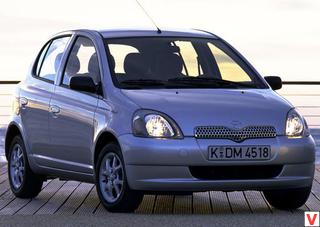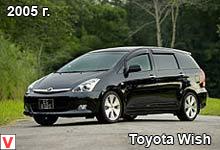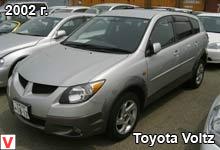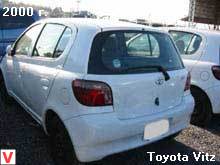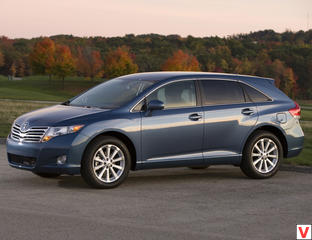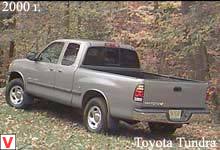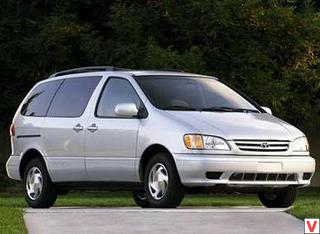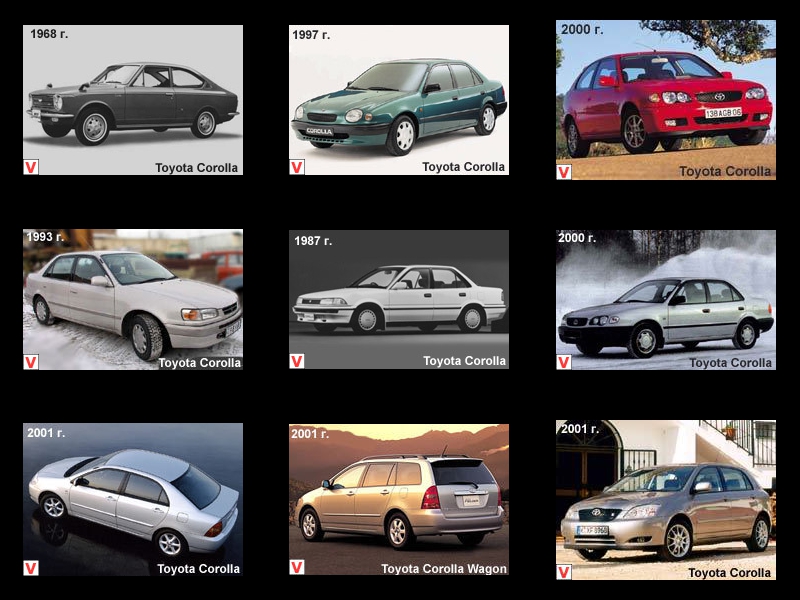
Toyota Corolla - compact car class C. The model, with a longitudinal engine arrangement and rear-wheel drive, was first introduced in 1966, and this model became a record in its class — the total number of cars sold was about 10 million units. Since 1966, nine generations of Corolla have entered the European market, raising the notoriety of the Toyota brand and helping to conquer the market. In terms of sales, each new generation of Corolla plays a major role in the company's operations. Nowadays, almost every one of the five Toyota cars produced in the world is the Corolla. Nearly 1 million Corolla vehicles are produced annually.
In terms of sales Corolla, the European market is in third place after Japan and North America, this market accounts for 20% of the world production of this machine. At that time and until 1997 inclusive, all Corolla were available in the following bodies: sedan, three-door compact, five-door compact, liftback, station wagon. However, all liftbacks had completely different body parts and optics that were not compatible with other models, since in Japan it was an independent model. The front-wheel-drive Toyota Corolla has been produced since 1984, but the combi and coupe GT variants still have rear driving wheels, i.e., a classic layout: the engine in front, the driving wheels are rear.
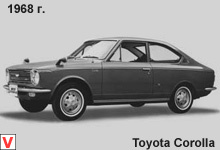
The following engines were installed on the Corolla of the classic layout: 1.2 liter gasoline engine 55 hp and 1.3 liters capacity 64 hp The engine capacity of 1.6 liters (1588 cm3, "lower" camshaft) with a capacity of 75 liters. from. with 1-chamber carburetor or 86 l. from. with 2-chamber and 1.6 liters (1587 cm3) capacity of 124 liters. from. with electronically controlled fuel injection. This engine is installed on the coupe version.
1.8 liter (1839 cm3) diesel engine with 58 hp capacity The following engines are installed on the Corolla front-wheel-drive design: a 1.3-liter capacity of 74 liters. from.; volume of 1.6 liters capacity of 71 hp with built-in catalyst in the exhaust system; diesel volume of 1.8 liters (1839 cm3), 64 hp With all its small flaws, such as the lack of spaciousness of the cabin, some engine noise, Corolla has good acceleration characteristics, high speed, low fuel consumption and amazing durability.
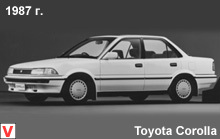
6 liters capacity of 71 hp with built-in catalyst in the exhaust system; diesel volume of 1.8 liters (1839 cm3), 64 hp With all its small flaws, such as the lack of spaciousness of the cabin, some engine noise, Corolla has good acceleration characteristics, high speed, low fuel consumption and amazing durability. 6 liters capacity of 71 hp with built-in catalyst in the exhaust system; diesel volume of 1.8 liters (1839 cm3), 64 hp With all its small flaws, such as the lack of spaciousness of the cabin, some engine noise, Corolla has good acceleration characteristics, high speed, low fuel consumption and amazing durability.
The sixth-generation Toyota Corolla debuted in 1987 in the back of the EE90. Outdated, to date, body design, but excellent build quality and good resistance to the appearance of corrosion, make this model quite popular in the secondary market. In addition, the undoubted advantages of the Toyota Corolla include high reliability of all components and assemblies, as well as decent driving performance. In the late eighties, with the first flow of right-hand drive cars from Japan, in particular, the first Corolla in the back of AE81 / 82 were brought. A little later, completely new carburetor sedans in the ninety of the body were purchased by barter.
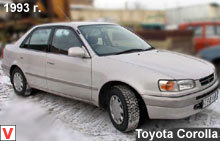
Many of them have safely survived to our days. Only four petrol engines were installed on the Corolla from 1987 to 1992: 1.3 (2E, carburetor), 1.3 (2EE, injection), both 12-valve, 1.6 (4AF, carburetor), and 1.6 (4A-FE, injection, who successfully migrated to the Corolla in the 100th body in the future). The generation of “blown” Corolla, called weave (in the body EE100), took place in 1992. The car has become a few centimeters wider than its predecessor, and even in the backseat the liftback has become somewhat more spacious. In the generation of the body EE100 rear suspension has been redone.
Faceless appearance, but a constant set of consumer qualities: good, smooth ride, decent handling, comfortable lounge and a pleasant steering combined with the ideal reliability of the car itself. In the year 94, a “facelift” was performed on the Corolla, i.e. modified grille, front bumper, rear optics), 4A-FE engine, 1600 cm3, 16 valves, multipoint fuel injection, 4wd full time (permanent all-wheel drive). This model was produced until 1997, when it was replaced by a new one. The debut of the Toyota Corolla 8th generation took place in May 1997.

The new “round-eyed” Corolla generation in the back with an index of 110 had several types: in addition to the sedan, they also produced 3– and 5 – door hatchbacks, a station wagon, and even a real “cafe-racer” Corolla G6, approaching the image of the VW Golf GTI. The Corolla liftback in this generation has been transferred to production in the UK. Each of these cars had three options for a complete set of salons: Linea Terra (the simplest), Linea Sol and Linea Luna. The new generation inherited from the predecessor the power frame of the body, on which hung new panels.
The concern decided to give its most popular model a non-trivial look, having decorated the front with bulging oval “big-eyed” headlights with round colored (rather than white, contrary to fashion) sidelights and trapezoidal grille trimming, which immediately distinguished it from the series of “classmates”. It looks interesting and front perforated bumper spoiler, and taillights with colorless oval "turn signals." And thanks to the new side windows with the belt line slightly raised to the tail and the new rims, the sedan is also visible from the side. True, this perspective is not so expressive, but compared with its predecessor, the positive developments are obvious.
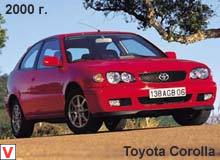
Independent suspension of all wheels remained unchanged and only slightly modified. This model was so much enjoyed by the public that it immediately deserved the honorary title “Car of the Year” in Europe. B refers to the so-called Euro-Corolla, which was produced specifically for the European market. In turn, the Toyota Corolla model for the North American market (unified with the Chevrolet Prizm) received its own, less original than the “European” version, body. The interior of the Corolla was also changed in the direction of a larger presence of smooth, oval and simply round shapes.
In this regard, the concern strictly adheres to the principle of unity of form and content: if the headlights are oval, then the ventilation control handles are round, not polo, as in all previous generations. A comfortable driver's seat with three seat adjustments with good lateral support, but the cushion adjustment algorithm is not entirely optimal. The height-adjustable steering column, large informative instrument scales, a nice-looking rounded dashboard, and excellent clarity on gears — these are also traditional features of Toyota Corolla that have been carefully cherished from generation to generation.
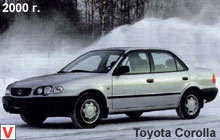
Colored fabric inserts in the doors create additional comfort but the trim of the cabin with light beige plastic and even the door sills cannot be considered practical. If the comfort in the front seats is quite decent, the rear passengers obviously do not have enough space above their heads, and if you don’t really pay attention to this in a sedan, then even people of average height will have to go with their heads tilted in order not to touch the ceiling. In this connection, the presence of a third head restraint in the back seat is puzzling.
At the same time, on the “cheap” versions, its back does not recline and does not allow to increase the trunk, which has become the norm already on the cheapest models of similar dimension. In general, the interior equipment on standard versions of the Toyota Corolla is just scant for the money, for which the “Koreans” offer almost a leather interior and mahogany trim, not to mention all kinds of electric drives. On the "Japanese" grade closer to the "Zhiguli" and not even down to the "dozens". Visibility is satisfactory, although the internal mirror could be larger.

The absence of a hatch from the cabin in the trunk is depressing - skiing on such a sedan is no easier to carry than in a “penny”. By itself, the trunk is quite decent, with a very low loading area. The choice of engines for the European model is small: the base is a 1.4-liter 16-valve 4E 86-horsepower with a carburetor. 4E-FE 88-strong with injection has a very moderate dynamics, although pulling at low revs. Engine displacement of 1.6 liters and 110 hp much more dynamic: acceleration to a hundred takes 10.2 seconds, and the maximum speed reaches 195 km / h. Diesel 2C-E with a working volume of 2.0 liters and 72 hp put mainly on the sedan.
Engine 7A-FE working volume of 1.8 liters and 110 hp put only on all-wheel drive wagon Corolla / Sprinter Wagon. This model, the heiress of Tercel Wagon 4WD, differs from most competitors with original rear lights raised to the rear racks. The dynamics of the new car has improved, there is still no vibration from the engine, and the noise that is taking place clearly is heard only at low gears and disappears completely on the 4th.

To the best of hard, very informative pedals, especially good brake, and the brakes themselves (front disc ventilated, with ABS) as before - beyond any criticism. Handling remained at the same level, i.e. On a slippery road, there is a demolition of the front axle, and when the "gas" is reset, the car pulls inwards. The backlash on the steering wheel is sufficient if the power steering is not worth it. Stability thanks to an independent rigid suspension is excellent, but its short-stroke and, as a result, strong recoil when driving large irregularities tire. So Corolla is a car for good roads.
Sharp shifting clarity, suspensions ("Mac Pherson" in front, 2-lever rear) on long waves does not allow unpleasant swing. The steering wheel also became noticeably lighter, and maneuverability, perhaps, has not changed, and there are no complaints about the turning radius of 4.8 m. However, to park and rebuild with the new power steering is much easier. The high level of safety of the car due to the high strength of the passenger compartment, forming a kind of cocoon.
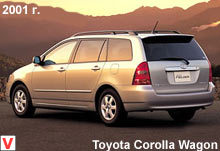
During the factory tests, the public has repeatedly demonstrated the practical invulnerability of the driver and passengers even with a frontal impact at a speed of 59 km / h. In 2000, the family of Japanese Corolla only updated. The demand for these cars fell and the classic Corolla no longer satisfied Japanese buyers. As you know, back in 1998, the Corolla lost its leadership in sales in Japan, skipping ahead of the Suzuki Wagon R.
In 1999, it dropped to fourth place. She was ahead of three models of the class Mini. As a result, the Corolla and its twin Sprinter in the local market sell only three body styles (sedan, station wagon and coupe). The European Corolla, assembled at Toyota’s factories in the UK and Turkey, in 2000 underwent a major modernization. The main distinguishing features - the new design of the front of the body, the new front bumper spoiler. However, the main changes are hidden inside. Almost completely updated power units. A new generation of more flexible 1.4-and 1.6-liter engines with systems of 97 and 110 hp VVT-i replaced the previous 1.3-and 1.6-liter engines.
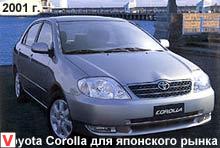
Diesel equipment received a new, more modern vortex-chamber 1.9-liter engine producing 69 hp. (instead of the previous 2.0-liter 75-strong). There are modifications with a station wagon and a 1.3-liter engine on an all-wheel drive chassis, as well as sports versions of the G6 with manual 6-speed gearboxes. The main premiere of 2001 in the European market is the new, ninth in a row, generation of the famous Corolla Class C model, which debuted in the autumn in Frankfurt.
The design of the new Corolla is almost revolutionary: a high sloping hood, a large slope of the front pillars, large triangular headlamps approaching the hood, perfectly steep wheel arches. Four-beam, multi-diffraction halogen headlights are installed, and the reversing lights are made round like high-beam headlights, which improves the illumination of the road when reversing. A characteristic feature of all modifications of the Corolla is an elegant stamping on the hood, emphasizing the enlarged emblem on the grille. Structural differences of the new Corolla chassis: a reinforced body and a new rear suspension on dual trailing arms, providing the best handling options.
New European Corolla with five different bodies: 3- and 5-door English-made hatchbacks, 4-door sedan made in Turkey, 5-door station wagon and Corolla Verso UPV, assembled in Japan. The wheelbase of all models increased by 135 mm (2600 mm). If earlier 3-and 5-door hatchbacks had different lengths, now for all it is the same - 4180 mm. The capacity of all models has increased significantly due to the increase in overall width by 20 mm (up to 1710 mm), and due to an increase in the height of the body from 1390 to 1475 mm (for hatchbacks). The body of the sedan and wagon became a little longer, and their overall height increased to 1470 and 1500 mm, respectively.
Even higher body (1610 mm) has a transformed interior Corolla Verso. Inside it became cozier and more comfortable. The interior of the cabin is made in black and gray. Used new fabric for upholstery and rearview mirror integrated with the display card. Also on this model is used instrument panel, all devices which are illuminated in red, with a tachometer and an external temperature indicator. The Corolla instrument cluster is equipped with an Optitron system.
When you turn on the ignition, you see the instrument lights that come on, and then a tachometer, speedometer, and fuel gauges and handbrake indicator. Due to the dark anti-glare background, devices with the Optitron system are notable for excellent readability in any light condition. And in models with automatic transmission, there is a double cup holder for passengers sitting in the back and the center console is enlarged.
Nothing squeaks and is pleasant to the touch. But, the steering column is not adjustable for the flight, but only for height. However, this ergonomics does not worsen, since it is compensated by a convenient location and precise operation of all buttons and levers. Corolla is available in three different configurations: CE, LE, and the new sports S. All models are equipped with transverse power units with engines of 90-192 hp.
Gasoline engines of 1.4, 1.6 and 1.8 liters - only 4-cylinder 16-valve with variable valve timing systemVVT-i (Variable Valve Timing - intelligent) with 97, 110, 135 and 192 hp capacity. The latest 1.8-liter engine for the CorollaT-Sport model is equipped with a VVTL-i system with variable valve lift. In addition, there is a 2.0-liter 16-valve diesel type D-4D with direct fuel injection and Common Rail fuel injection system in versions of 90 and 110 hp.
The basic power unit for all models (except Verso) is a 1.4-liter engine with 90 hp. More powerful performance equip 1.6-liter engine 110 hp Corolla Verso complement the 1.6 - and 1.8-liter "fours" in 110 and 135 hp The interaction of government thought out well. You release the clutch and add gas - the car starts moving smoothly without jerking, as in theory. The steering wheel is, on the whole, informative. The model is equipped with an independent MacPherson front suspension with anti-roll bar. Rear suspension - torsion bar. Suspension turned harsh - on potholes body trembles and shakes.
Especially shakes on large potholes at low speeds. However, at high speed, the machine does not swing and swallows fairly large holes without problems. Another useful point - high ground clearance for a golf class - 17 cm. This is a couple of centimeters higher than that of most Corolla classmates.
Therefore, on a gravel road, on a lawn, or, say, on a road with chipped asphalt, she feels confident. The perfect quality of all the characteristics of the new Corolla is reflected in a wide range of security tools. Under any, even the sharpest braking, control over the car will remain thanks to the anti-lock ABS system, which distributes the braking force between all four wheels, ensuring each of them maximum grip. The VSC system automatically aligns the trajectory in the event of a skid. It redistributes the engine torque, removing the car from slipping and helping to stabilize the trajectory of movement.
The entire range of engines is complemented by Brake Assist systems for emergency braking and traction control TRC. Improved safety in collisions: front and rear deformable zones, reinforced struts and side guard bars protect the driver and passengers upon impact. To improve the driver's safety, a “breaking” pedal assembly bracket and an energy-absorbing folding steering column are provided. Add to this the already-for-part toyotov reliability, high build quality and airbags for those in front. “Hot” Toyota Corolla T Sport is offered only in a richly equipped version with air conditioning, four airbags, music, etc. etc. With 1800-cc engine, the Corolla T Sport shoots 188 hp.
at 7800 rpm and 180 Nm at 6800 rpm. A six-speed manual gearbox with “close together” gear ratios makes it possible to keep the tachometer needle in a narrow zone of greatest thrust. In addition, the suspension characteristics were corrected, the anti-skid and anti-slip systems were installed, and the dimensions of tires and wheels were changed (195 / 55R16). However, all this is worth a lot, so that the base 1400-cc sedan Corolla will cost half the price. Both outside and inside, the finish of the T Sport is slightly different from the basic version.
The most noticeable is a slightly different instrument panel, silver inserts on the console and chrome on the gear lever. The driver's seat is very comfortable and has a large range of adjustments, including height. The spacious cabin slightly pressed the trunk, limiting its volume to 290 liters, while the standard for the analogs was 330 - 370. True, this did not prevent the full-size spare tire from being placed under the floor. In November 2003, Toyota introduced the Corolla XRS. The car comes with a 6-speed manual gearbox and a 1.8 liter four-cylinder DOHC 2ZZ engine, which are already known for the Celica GT-S and Matrix XRS models.
In contrast, the Corolla XRS engine was revised in the gas distribution part and received a proprietary system of variable valve opening phase VVTL-i. As a result, the Corolla XRS engine became more resilient, and the highest power of 170 hp. it reaches in the range of 6000-7800 revolutions per minute. Acceleration from zero to 100 km / h this engine provides for 8 seconds. Modification of the suspensionToyota ordered from Yamaha. It has become tougher with the increase in energy consumption due to the use of special shock absorbers and springs of increased diameter.
From the visual differences of the Corolla XRS from the standard models, we note the 16-inch Michelin wheels with aluminum wheels instead of the 15-inch wheels. In addition, the car received sports seats and leather interior. Toyota set out to launch the Corolla XRS series in May next year on the assembly line of its assembly plant in Cambridge (Canada). In 2006, the Corolla name turned 40 years old, during which ten generations of these affordable and reliable cars changed, and the total output exceeded 32 million. Anniversary, the tenth generation of the best-selling Corolla decided to share.
The sedan is still called the Corolla, and the hatchback, built on a similar chassis, got its own name - Auris, and became a separate model in the Toyota lineup. In Russia, the tenth generation began to sell since February 2007. The car was produced for the Russian and European market with two engines of 1.4 and 1.6 liters, with a capacity of 97 and 124 hp.
respectively. And if the 1.4 engine was inherited from the previous model with little or no change, the 1.6 liter power unit, equipped with the Dual VVT-i variable valve timing system, was developed almost from scratch. The choice of two gearboxes - a five-speed mechanics and it is the same, but with a robotic clutch.
The body design depends on the country where the car is sold: in the USA it is more aggressive, in Europe and Asia it is more restrained. The European and Russian versions are basically identical, the latter is distinguished by a more capacious battery, other suspension settings and a clearance of 150 mm. The design of the Japanese version is much more Asian motifs. In addition, the machine is 65 mm narrower and 130 mm shorter - these are the requirements of local standards.
The basic package of "Comfort" includes ABS (anti-lock braking system), EBD (emergency braking system), airbags - 4 pcs., Air conditioning, power windows (front), headlight washers, heated seats (front), heated and electric exterior mirrors, central locking, immobilizer, CD radio (mp3). Grade "Elegance" also adds rear electric windows, as well as airbags (additional side and knee), automatic climate control, two additional speakers, a leather steering wheel with control keys for the audio system, fog lights. Cars with an engine of 1.4 liters are equipped with wheels and tires 195/65 / R15, and with an aggregate of 1.6 liters - 205/55 / R16.
Alloy wheels are put on the configuration "Prestige". This package also includes a light sensor, rain sensor, electrochromic rear-view mirrors, cruise control, Smart Entry access system and engine start via the Push Start button. In 2010, the model underwent restyling and technical refinement, the main purpose of which was to modernize the car to modern standards and preserve the existing advantages. The design has traditionally been made in a restrained and practical style. By the way, the restyled Corolla is represented only in the sedan.
The hood of the 2010 Corolla is sloping and long, due to which the dimensions of the car were slightly increased. In the exterior, the most significant changes affected the grille, bumpers and dipped headlights. Also, designers have worked on the side mirrors, equipping them with turn signals. Thanks to all these changes, the car received a brighter appearance and began to be perceived much more dynamically. The interior of the Corolla sample of 2010 was made neat, harmonious and ergonomic. The first to be noticed is an updated steering wheel, which differs from the previous version with a thicker rim, a smoothed lower part and, of course, new buttons.
The color palette was supplemented with light and dark gray tones, in addition, it became possible to order Alcantara trim. It is also worth noting that to connect to the audio system you can now use a USB-connector, which the previous model lacked so much. Roomy trunk: 450 liters. Increase the space by folding the back of the back row in the ratio of 60:40.
As a power unit can be used gasoline engine Dual VVT-i with a volume of 1.3 or 1.6 liters. As a matter of fact, these motors were installed on the previous generation, they proved themselves so well that the concern decided to keep them in the ranks, providing only a few modifications. The power of the 1.3-liter engine is still 101 hp, however, fuel consumption was reduced to 5.9 liters, and the CO level was reduced to 139 g / km. The 1.6-liter engine increased power to 124 hp, which, however, did not prevent the reduction of CO emissions to 164 g / km, and fuel consumption remained the same - 6.9 liters per 100 km.
There are also two gearboxes: a 6-speed manual and a four-band “automatic”, which is installed only with a 1.6 petrol engine. Suspension restyled modification softened. Ahead set the usual McPherson racks, behind - a torsion beam. There are five complete sets of Corolla 2010 on the Russian market. The basic configuration of the Comfort includes heated and electric side mirrors, door handles and side mirrors in body color, 4 speakers, front electric windows, air conditioning, heated front seats, immobilizer, front and side mirrors airbags. It turns out a fairly large set, even though not all are listed.
The Comfort Plus package differs only in the size of steel discs, it contains 16 "instead of 15". The following equipment "Elegance" has a folding side mirrors, chrome grille, rear chrome trim, 4 speakers, a full-fledged audio system with AUX and USB connectors, as well as a multifunctional steering wheel. The complete set "Elegance Plus" was equipped with cast wheels, fog lights, climate control, curtain airbags and an important knee airbag driver. Top of the range “Prestige” is equipped with rain and light sensors, an electrochromic rear-view mirror with a rear-view camera, cruise control, intelligent car access system and Bluetooth communication system.
The eleventh generation of the Toyota Corolla model has been produced since 2012 in Japan. In 2013, the debut version for the American and European markets. Externally, cars differ from each other design of the front and rear. Thus, the European version of the Corolla received a wider chrome grille, headlights heading to the windshield, elongated taillights, and other bumpers. In general, the exterior of the 2013 Corolla is more aggressive in appearance.
The model added in size, the length of the car is 4620mm (+80), width 1775 mm (+15), height 1465 mm (-5 mm). 100 mm increased wheelbase. European and American Corolla XI received and different engines. In the USA, the line of power units consists of two gasoline engines of 1.8 liters - 132 hp. and 140 horsepower. Together with them are offered, a four-stage automatic, six-speed mechanics and a CVT. Three petrol engines are available in Europe and Russia: 1.3 l (99 hp), 1.6 l (122 hp) and 1.8 l (140 hp). The weakest engine only works in tandem with six-speed mechanics.
It is not dynamic, acceleration from zero to hundred takes 12.6 seconds. Fuel consumption of a 1.3 liter motor - 5.4 liters on the highway, 7.1 liters in the city. The 1.6-liter engine is aggregated with both a six-speed manual gearbox and a variator. The most powerful engine is offered only with the CVT.
Together with him, he accelerates the car from 0 to 100 km / h in 10.1 seconds. Inside the 2013 Corolla looks very restrained, especially compared to the exterior design. The interior is stylish, simple and comfortable. High-quality materials, the dashboard reads perfectly, the seats are comfortable.
Already in the standard equipment there are LED headlights, car-colored handles and mirrors, eight airbags, power windows, air conditioning, heated seats and central locking. More expensive versions offer light and rain sensors, leather and fabric upholstery, dual-zone climate control, and a good multimedia system. The basic colors for the body are white and dark blue, other colors are available for an additional fee.

